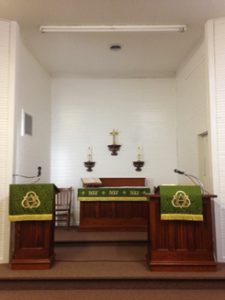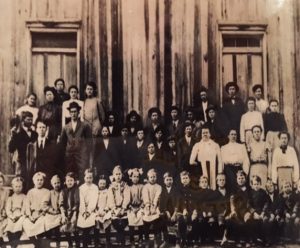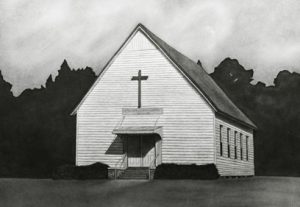Like most Evangelical Lutheran Churches in America, Beth-Eden Lutheran Church begins every worship service with The Order of Confession and Forgiveness:[1] As worship begins, water is poured into a baptismal font so that as the people see and hear the water, they might remember their baptism. To encourage this, the liturgy begins with the words they were baptized with:
P: In the name of the Father, and of the + Son, and of the Holy Spirit.
C : Amen
P: Almighty God, to whom all hearts are open, all desires known, and from whom no secrets are hid: Cleanse the thoughts of our hearts by the inspiration of your Holy Spirit, that we may perfectly love you and worthily magnify your holy name, through Jesus Christ our Lord.
C: Amen
P: If we say we have no sin, we deceive ourselves, and the truth is not in us. But if we confess our sins, God who is faithful and just will forgive our sins and cleanse us from all unrighteousness.
P: Most merciful God,
C: we confess that we are in bondage to sin and cannot free ourselves. We have sinned against you in thought, word, and deed, by what we have done and by what we have left undone. We have not loved you with our whole heart: we have not loved our neighbors as ourselves. For the sake of your Son, Jesus Christ, have mercy on us. Forgive us, renew us, and lead us, so that we may delight in your will and walk in your ways, to the glory of your holy name. Amen
P: Almighty God, in his mercy, has given his Son to die for us and, for his sake, forgives us all our sins. In the name of the Father, and of the + Son, and of the Holy Spirit, you are forgiven.
C: AMEN.
Ironically, there was no baptismal font in the church when I began to serve there. Did that provide a clue to what else might be missing in the Christian life of the congregation? To this ordained elder in the United Methodist Church serving one of our full communion partner churches, the liturgy was rich and powerful. To the congregation, the liturgy appeared to have run dry and become rote. Ostensibly, the words we said to God in worship, did not look as if they impacted some congregants’ words and actions after worship, as evidenced by examples where we did “not love our neighbor as ourselves.”
Melanie Ross writes,
“Among other things, good worship is formative, expressive, grounded in Trinitarian theology, responsive to the needs of the local assembly, and concerned with outreach into the wider world.”[2]
When present, these elements ostensibly create an inherent transformational power that can shape the people into something that is distinct from the world. The world of the rural south is anchored deeply in the local church, and sometimes it is not evident which is shaping which, resulting in a dilemma for pastors.
A distinction of rural life is the convergence of its particular history, society, and culture. Socialization is the process of learning the expected norms and customs of a group by way of social interactions. Customs are the long-standing practices developed over time. The rural church reflects many Christlike practices such as sharing extra produce from the garden, serving meals to grieving families, and praying for the sick in the community. From time to time, however, less generous practices crop up in the form of racist attitudes, an unwillingness to help a neighbor in need, or resistance to reinterpretation of deeply held religious beliefs. Within the worship service, is there a way to address the difference in what we say to God in worship and “our thoughts, words and deeds” after worship? If the power of the liturgy had dried up for the people, might the sermon be the place to help people understand and tap into the living water offered to them in the liturgy? Can the long-established practices of worship, change or shape the long-established practices that regulate the lives of the congregants so that they are “freed in Christ” to live out the Great Commandment to love God with all our heart, mind, soul and strength, and to love our neighbor as ourselves?”[3]
With these questions in mind, I set out to explore the histories of Beth-Eden Lutheran Church, the practice of Confession of Sin, and the “southern way of life”[4] and discovered mystagogical preaching. The Early Church employed mystagogical preaching to help new disciples comprehend the sacraments and sacramental life they had been initiated into. Craig Satterlee, a Lutheran liturgical scholar, posits,
“Mystagogical preaching is distinct from other types of preaching in that it draws the hearers into the mysteries, moving them to enter spiritually and intellectually into the rites in which they have previously participated but may have only understood in terms of sense-perception.”[5]
Mystagogical preaching was not a form of education, but one of formation in the ways they would live out the birth, life, death, and resurrection of Jesus Christ. This formation involves reflection upon the ritual they are participating in to find deeper meaning in what they are doing. For instance, Baptism (should) occur once in a person’s life, but the understanding of dying to self and being raised to new life in Christ can be applied to one’s actions every day. Daily genuine repentance leads to renewal, which, over time, forms faithful believers who “proclaim God’s love in word and deed.”
The mystagogical sermon has a bent towards a realized eschatology that gives listeners a vision for what it means to “delight in [God’s] will and walk in [God’s] ways.” Within the reflection is an invitation to be changed by the “mysteries of faith” as well as to change their thoughts, words, and deeds into those that honor God, neighbor and self.[6] Mystagogical preaching offers time for meditating on the ritual, as well as its meaning in the listener’s life in such a way that a life in Christ is formed.
Over the centuries, the Christian Church began to include Confession of Sin in worship. Confession acknowledges sin and any impact sin has on others. Confession invites parishioners to repent, to turn away from sinful thoughts, words and deeds and to respond, to turn towards those that honor God, neighbor, and self. Confession is necessary because sin distorted the image of God in humanity and humans cannot restore themselves. The practice of confession of sin includes an absolution when forgiveness is declared over all participating in it. Absolution calls for genuine repentance.
Ostensibly, the practice of Confession and Forgiveness contains within it the renewing power of Baptism, as the grace and mercy of God washes away the revealed sin. The sign of the cross[7] made by the pastor connects Baptism, one’s entrance into the Body of Christ, to the confession of sin. In the Large Catechism, Martin Luther states, “Repentance, therefore is nothing else that a return and an approach to Baptism, that we repeat and practise what we began before, but abandoned.”[8] Therefore, the practice of Confession and Forgiveness contains within itself, confession, repentance, and absolution of sin. Absolution calls for repentance. Genuine repentance demands a response, a return to the ways of God, that offers the renewal or the new life in Christ. Martin Luther felt so strongly about the power of Confession and Forgiveness that it was named as the third sacrament in Article XIII of the Apology to the Augsburg Confession-“Absolution, which is the Sacrament of Repentance.”[9]
In the Lutheran Church, three opportunities for Confession and Forgiveness are offered: corporate confession, individual confession, and confession immediately prior to receiving Holy Communion. Regardless of which rite one is participating in, it must be titled “Confession and Forgiveness” for each is the other side of the same coin.[10] On two occasions I preached on the Order of Confession and Forgiveness being the core of what it means to be “freed in Christ.”
Bishop Elizabeth Eaton of the Evangelical Lutheran Church of America called us to enter a day of Confession and Repentance following the shooting of nine members of Mother Emanuel African Methodist Episcopal Church in Charleston, South Carolina. To begin worship that Sunday, I spoke her words:
“It has been a long season of disquiet in our country. From Ferguson to Baltimore, simmering racial tensions have boiled over into violence. But this … the fatal shooting of nine African Americans in a church is a stark, raw manifestation of the sin that is racism… We need to be honest about the reality of racism within us and around us. We need to talk and we need to listen, but we also need to act. No stereotype or racial slur is justified. Speak out against inequity. Look with newly opened eyes at the many subtle and overt ways that we and our communities see people of color as being of less worth. Above all pray – for insight, for forgiveness, for courage.”[11]
Her words were followed by five minutes of silence to reflect upon this tragic act of violence, as well as the difference our faith in Jesus Christ would have on our response.
On Reformation Day, I preached a sermon reciting the familiar story of Martin Luther nailing his 95 Thesis to the door of the Wittenberg Church with the explanation that the door served as a bulletin board of sorts for people wishing to enter a deeper conversation about a topic. I invited the congregation to enter a deeper conversation about the non-compatibility of white supremacy and Christianity, as well as specific teachings on the transformational power contained in confession, repentance, and forgiveness. This was followed by five minutes of silence to reflect upon the ongoing sin of racism, as well as the difference our faith in Jesus Christ would have on our response.
“To understand the world, you must first understand a place like Mississippi.”[12]
Rural culture is anchored in local institutions, and principle among these institutions is the local church. Embodied within the church are the customs and values of the larger community. Preaching Christ in a rural southern culture that is resistant to change comes with blessings and curses. If these customs or practices reflect the gospel of Jesus Christ, they become gifts of the church to share freely. If these customs or practices are contrary to the gospel of Jesus Christ, the pastor is faced with a dilemma: accepting the contrary practice and losing their soul or addressing the contrary practice and losing their ministry appointment.
This project revealed that the people of Beth-Eden Lutheran Church, like most churches, Beth-Eden Lutheran Church is full of good, faithful people, and simultaneously unfaithful people, some of whom follow the Southern Way of Life more closely than following the way of Jesus. Even understanding themselves to be Christian, some did not feel compelled to love their neighbor until that commandment was taught and preached. The influence of the “southern way of life” reached inside the church, and some people seemed surprised to learn that there is no God ordained hierarchy of the races, but instead, an equality found in the Body of Christ where all sinners are welcome.
Although a direct causal connection cannot be drawn between words we say to God in worship and our words and actions towards others after worship, there is evidence of lives being changed. A neighbor, Mr. Fuller, had a liver transplant. Initially, when I asked how we would care for our neighbor, I was told, “We don’t have to. He is not a member of this church; he’s a no-good Fuller.” After we had corporately confessed our sin of racism after the Dylan Roof shooting, I put a sign-up sheet to take them meals in the back of the sanctuary. During announcements, I stated how proud I was to be the pastor of a church that loved their neighbor in real ways. I invited them to sign up for a night and to take their signature dishes to the Fullers. The sheet filled up and the Fullers were surprised by all the delicious meals.
More surprising changes came in the Spring when people in the church noted that the Fullers had not been able to keep up with their yardwork and suggested that we “love our neighbor by taking care of his land.” The next fall when Mr. Fuller was in a wheelchair, another person suggested that we have a day of service and build him a ramp so that he could get into his house easier. Another great day was spent with members of the church where Mr. Fuller attends,[13] a ramp was built, and accessibility given to a more independent life. It is not clear if mystagogical preaching was what softened the people’s hearts to love their neighbor as themselves, but the Holy Spirit certainly moved through the congregation opening their eyes to see a neighbor in need, as well as a compassionate way to care for him.
The sermon that directly named racism as a sin alongside the Order of Confession and Forgiveness met resistance and anger. From that reaction, I learned not only is time for reflection needed in worship, but time outside of worship is needed for reflection, questions, and experiences to be shared. When I offered that time to one man who was particularly angry with me, he said, “It’s interesting how your experience shaped your whole understanding of Jesus. I’m not sure why I let those two bad experiences shape the way I see black people. I certainly had been bullied by white kids and didn’t stop being friends with all white people.” He was silenced by his own revelation.
This project is relevant to pastors and congregations of the mainline Protestant churches today. A Hartford Institute for Religion Research study showed that 59% of churches in the United States have 7-99 members. In the Rural South, the percentage of small membership churches rises to 70.5%.[14] The National Congregational Study (NCS) shows that from 1998 to 2012, the number of small membership churches has grown from 37.8% to 42.7%.[15] These numbers can only be expected to rise with the decline of memberships across mainline Protestant church. As churches become smaller, the members tend to cling more tightly to long-held traditions, creating a dangerous cycle as pastors try to preach Christ in life-changing ways.
No formula of liturgy and life can be constructed and replicated to ensure that the words people pray in worship shape their words and actions after church lets out, for this is the holy work of God alone, a true “mystery of the faith.” Nonetheless, continuing to practice confession and forgiveness, continuing to teach and mystagogically preach the meaning of the rites of Lutheran worship, and continuing to cast an eschatological vision of what it means to “do justice, to love kindness and to walk humbly with God” (Micah 6:8) will continue to let God “forgive, renew, and lead us so that we may delight in [God’s] will and walk in [God’s] ways, to the glory of [God’s] holy name. Amen.”[16]
[1] Lutheran Church in America, American Lutheran Church (1961-1987), Evangelical Lutheran Church of Canada, and Lutheran Church–Missouri Synod. Lutheran Book of Worship. (Minneapolis: Augsburg Publishing House, 1978), 56.
[2] Melanie Ross, “Evangelical Versus Liturgical? Defying a Dichotomy,” Liturgy, The Journal of the Liturgical Conference 29, no. 2 (2014): 17.
[3] Matthew 22:26-40.
[4] One of the oldest stories the South carries with it is the God ordained separation and hierarchy of the races. Carleton Putnam, Race and Reason: A Yankee View (Washington D.C.: Public Affairs Press, 1961), 67.
[5] Craig A. Satterlee, Ambrose of Milan’s Method of Mystagogical Preaching (Collegeville, Minnesota: Liturgical Press, 2002), 1.
[7] In Baptism, we are washed in the name of the Father, Son and Holy Spirit and “marked with the cross of Christ forever”.
[8] Pfatteicher and Messerli, 151.
[9] Philip Melanchon, the author of the Apology written in 1530, called it “Absolution, which is the Sacrament of Repentance.”
[10] Pfatteicher and Messerli, 189.
[11] “ELCA Leaders Express Grief over Shooting in South Carolina,” last modified June 18, 2015, accessed February 22, 2018, http://elca.org/News-and-Events/7753.
[12] Although often attributed to William Faulkner, no one knows who said it originally. For more information, please see: Melissa Block, “William Faulkner’s Home Illustrates His Impact on the South,” All Things Considered, February 13, 2017, accessed February 21, 2018. https://www.npr.org/2017/02/13/515043640/william-faulkners-home-illustrates-his-impact-on-the-south.html
[13] These two churches had never collaborated on anything else before this day.
[14] “What is the size of U.S. Churches?,” Hartfield Institute for Religion Research, last modified December 17, 2015, accessed February 28, 2018, http://hirr.hartsem.edu/research/fastfacts/fast_facts.html#sizecong.
[15] “Size of Congregation by Year of Survey,” The Association of Religion Data Archives, last modified March 9, 2018, accessed February 28, 2018, http://www.thearda.com/ConQS/qs_295.asp.
[16] LBW, 56.





What an amazing and concise explanation and apologia for the use of Confession and Forgiveness in the Lutheran Church. Thank you so much. Is there a way I can quote from this and cite it?